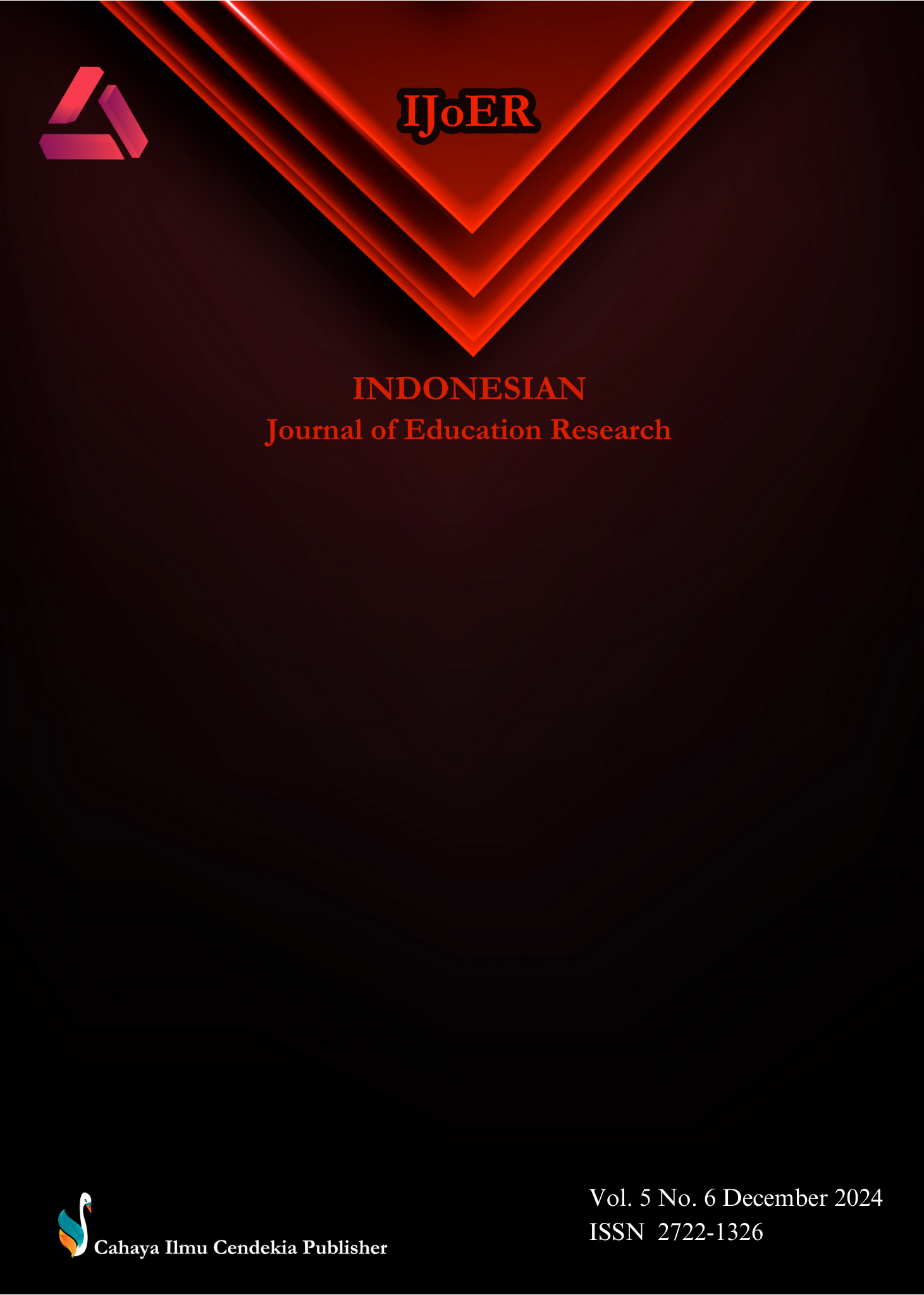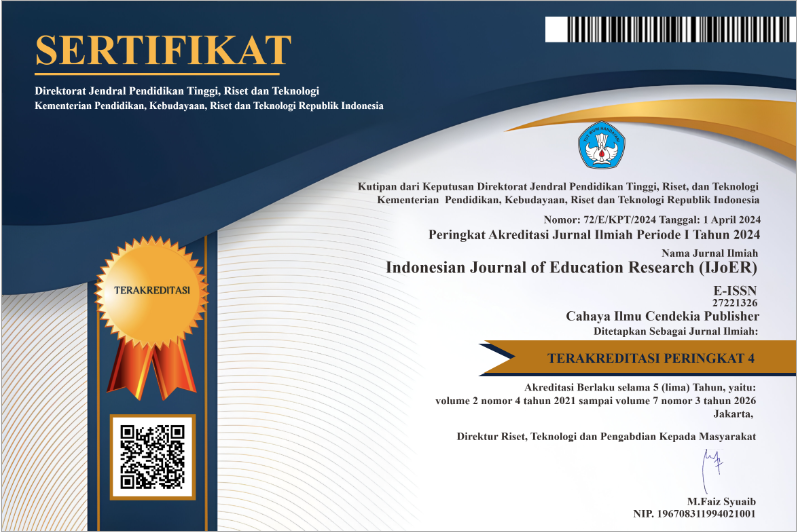A Validity of E-LKPD Based on Problem Based Learning for Improve Critical Thinking Skill
Abstract
Purpose of the study: This study aims to determine the validity of the developed E-LKPD.
Methodology: The data obtained from the experts were analyzed by considering comments or suggestions using the Content Validity Ratio (CVR) and Content Validity Index (CVI). This E-LKPD product validation sheet was validated by 7 experts, namely 2 lecturers from the Malaysian University of Technology, 2 lecturers from Sriwijaya University, 2 junior high school teachers, and 1 Laboratory Practitioner. This product is validated in the aspects of design, content, Problem Based Learning, and aspects of students' critical thinking skills.
Main Findings: The results of the validity of the E-LKPD conducted by 7 validators are allowed to be used. because the overall value of the E-LKPD aspect (S-CVI / AVE) is 0.95 and falls into the category of a very strong level of validity. while the S-CVI /UA score is 1 so that it can prove this product can be used for teaching materials from teaching and can improve students' thinking skills through the problem-based learning model.
Novelty/Originality of this study: The novelty of this research lies in the validators who validated this E-LKPD so that it can be developed into a better product using CVR and CVI.
References
S. Markos Siahaan, E. Astra Patriot, S. Scristia, H. Helen, U. Kalsum, and R. Elsa Putri, “The Validity and Practicality of Augmented Reality-Based Media Development on Science Matter,” J. Pendidik. MIPA, vol. 24, no. 4, pp. 717–729, 2023, doi: 10.23960/jpmipa/v24i4.pp717-729.
M. Afriandi, “Pengembangan dan Pemanfaatan Bahan Ajar,” J. Undiksha, vol. 6, no. 2, pp. 64–71, 2020.
T. M. Sholihah and B. Lastariwati, “Problem based learning to increase competence of critical thinking and problem solving,” J. Educ. Learn., vol. 14, no. 1, pp. 148–154, 2020, doi: 10.11591/edulearn.v14i1.13772.
A. Haleem, M. Javaid, M. A. Qadri, and R. Suman, “Understanding the role of digital technologies in education: A review,” Sustain. Oper. Comput., vol. 3, no. February, pp. 275–285, 2022, doi: 10.1016/j.susoc.2022.05.004.
L. A. Ilmy, M. Zaini, and A. Rezeki, “Studi penggunaan LKPD-Elektronik konsep keanekaragaman hayati terhadap hasil belajar dan keterampilan berpikir kritis,” Pract. Sci. Teach. J. J. Prakt. Pendidik., vol. 1, no. 2, pp. 97–105, 2022, doi: 10.58362/hafecspost.v1i2.12.
M. Y. C. A. Kek and H. Huijser, “The power of problem-based learning in developing critical thinking skills: Preparing students for tomorrow’s digital futures in today’s classrooms,” High. Educ. Res. Dev., vol. 30, no. 3, pp. 329–341, 2011, doi: 10.1080/07294360.2010.501074.
A. Miftahatuljannah, R. Budhiarti, and A. Fauzi, “Pengembangan Modul Pembelajaran Elektronik Fisika Berbasis Learning Content Development System (LCDS) pada Materi Besaran dan Pengukuran,” J. Sains Edukatika Indones., vol. 3, no. 2, pp. 1–8, 2021, https://jurnal.uns.ac.id/jsei/article/view/70897.
Y. Darmawati and A. Mustadi, “The Effect of Problem-Based Learning on the Critical Thinking Skills of Elementary School Students,” J. Prima Edukasia, vol. 11, no. 2, pp. 142–151, 2023, doi: 10.21831/jpe.v11i2.55620.
M. Roza and R. Chania, “Pengembangan LKPD Berbasis Praktikum pada Pembelajaran IPA di Madrasah Tsanawiyah,” Nat. Sci. J., vol. 4, no. 2, pp. 664–675, 2018, doi: 10.15548/nsc.v4i2.459.
C. C. Haryanto and K. Kusmiyati, “Analisis Penerapan Model Pembelajaran Problem Based Learning Dalam Meningkatkan Kemampuan Berpikir Kritis Siswa Sekolah Dasar,” Teach. J. Inov. Kegur. dan Ilmu Pendidik., vol. 2, no. 3, pp. 307–315, 2022, doi: 10.51878/teaching.v2i3.1664.
H. Yuan, W. Kunaviktikul, A. Klunklin, and B. A. Williams, “Promoting Critical Thinking Skills Trough Problem-Based Learning CMU,” C. J. Soc. Sci. Hum., vol. 2, no. 2, pp. 85–100, 2008, https://www.thaiscience.info/journals/Article/CMUS/10613690.pdf.
A. Martone and S. G. Sireci, “Evaluating alignment between curriculum, assessment, and instruction,” Rev. Educ. Res., vol. 79, no. 4, pp. 1332–1361, 2009, doi: 10.3102/0034654309341375.
K. Anderson, E. Care, H. Kim, and A. Vista, “Education system alignment for 21st century skills: Focus on assessment,” Cent. Univers. Educ. Brookings Institution., no. January, pp. 1–40, 2018, doi: 10.1111/cdev.13673.
T. M. Bhuttah, Q. Xusheng, M. N. Abid, and S. Sharma, “Enhancing student critical thinking and learning outcomes through innovative pedagogical approaches in higher education: the mediating role of inclusive leadership,” Sci. Rep., vol. 14, no. 1, pp. 1–13, 2024, doi: 10.1038/s41598-024-75379-0.
S. F. Rivas, C. Saiz, and C. Ossa, “Metacognitive Strategies and Development of Critical Thinking in Higher Education,” Front. Psychol., vol. 13, no. June, 2022, doi: 10.3389/fpsyg.2022.913219.
A. Khovivah, E. S. Gultom, and S. S. Lubis, “Pengembangan Lkpd Berbasis Problem Based Learning Dan Pengaruhnya Terhadap Keterampilan Berpikir Kritis Siswa,” LENSA (Lentera Sains) J. Pendidik. IPA, vol. 12, no. 2, pp. 152–161, 2022, doi: 10.24929/lensa.v12i2.258.
A. Işik, “ELT Materials Evaluation: A System and Criteria,” Theory Pract. Lang. Stud., vol. 8, no. 7, p. 797, 2018, doi: 10.17507/tpls.0807.11.
M. S. Hadi and L. Izzah, “Problem Based Learning (PBL) in Teaching English for Students of Primary School Teacher Education Department,” English Lang. Focus, vol. 1, no. 1, p. 45, 2019, doi: 10.24853/elif.1.1.45-54.
N. Nurjanah and G. Trimulyono, “Pengembangan E-LKPD Berbasis Problem Based Learning untuk Melatihkan Keterampilan Berpikir Kritis pada Materi Hereditas Manusia,” Berk. Ilm. Pendidik. Biol., vol. 11, no. 3, pp. 765–774, 2022, doi: 10.26740/bioedu.v11n3.p765-774.
D. F. Polit and C. T. Beck, “The content validity index: Are you sure you know what’s being reported? Critique and recommendations,” Res. Nurs. Heal., vol. 29, no. 5, pp. 489–497, 2006, doi: 10.1002/nur.20147.
G. E. Gilbert and S. Prion, “Making Sense of Methods and Measurement: Lawshe’s Content Validity Index,” Clin. Simul. Nurs., vol. 12, no. 12, pp. 530–531, 2016, doi: 10.1016/j.ecns.2016.08.002.
R. . Stiggins, “Assessment crisis: the absence of assessment for learning,” Kappan Prof. J., 2002.
C. Ayre and A. J. Scally, “Critical values for Lawshe’s content validity ratio: Revisiting the original methods of calculation,” Meas. Eval. Couns. Dev., vol. 47, no. 1, pp. 79–86, 2014, doi: 10.1177/0748175613513808.
N. Aini and R. T. H. Putri, “Validity of E-LKPD to Train Students’ Critical Thinking Abilities,” Appl. Appl. Sci. Learn. Res., vol. 4, no. 1, pp. 33–39, 2024, doi: 10.32764/application.v4i1.4699.
M. S. B. Yusoff, “ABC of Content Validation and Content Validity Index Calculation,” Educ. Med. J., vol. 11, no. 2, pp. 49–54, 2019, doi: 10.21315/eimj2019.11.2.6.
N. Darwis, A. A. Azis, D. Dwi, P. Ulan, and S. Patongai, “The Practicality of Electronic Biology-Based Student Worksheets (LKPD) Scientific Approach,” Indones. J. Biol. Educ., vol. 6, no. 2, pp. 52–60, 2023, doi: 10.31002/ijobe.v6i2.453.
R. A. Adawiyah, “Pengembangan LKPD Biologi Berbasis Problem Based Learning (PBL) Untuk Mengembangkan Motivasi Belajar Siswa Pada Materi Sistem Imun Di Kelas XI IPA SMA Negeri Umbulsari …,” 2022, http://digilib.uinkhas.ac.id/id/eprint/14498%0Ahttp://digilib.uinkhas.ac.id/14498/1/Robi%27ah Al Adawiyah_T20188052..pdf
L. Wijngaards-de Meij and S. Merx, “Improving curriculum alignment and achieving learning goals by making the curriculum visible,” Int. J. Acad. Dev., vol. 23, no. 3, pp. 219–231, 2018, doi: 10.1080/1360144X.2018.1462187.
S. Mubarak, E. Susilaningsih, and E. Cahyono, “Pengembangan Tes Diagnostik Three Tier Multiple Choice Untuk Mengidentifikasi Miskonsepsi Peserta Didik Kelas XI,” J. Innov. Sci. Educ., vol. 5, no. 2, pp. 101–110, 2016, https://journal.unnes.ac.id/sju/jise/article/view/14258.
Elvia Derta, Siska Nerita, and Annika Maizeli, “Validitas E-LKPD Interaktif Berbasis Discovery Learning Pada Materi Keanekaragaman Hayati Untuk Fase E SMA/MA,” DIROSAT J. Educ. Soc. Sci. Humanit., vol. 1, no. 2, pp. 51–57, 2023, doi: 10.58355/dirosat.v1i2.11.
Copyright (c) 2024 Dariah Meitaza, Ida Sriyanti, Leni Marlina, Nur Najihah Binti Zulkarnain

This work is licensed under a Creative Commons Attribution 4.0 International License.
Authors who publish with this journal agree to the following terms:
- Authors retain copyright and acknowledge that the Indonesian Journal of Education Research (IJoER) is the first publisher licensed under a Creative Commons Attribution 4.0 International License.
- Authors are able to enter into separate, additional contractual arrangements for the non-exclusive distribution of the journal's published version of the work (e.g., post it to an institutional repository or publish it in a book), with an acknowledgment of its initial publication in this journal.
- Authors are permitted and encouraged to post their work online (e.g., in institutional repositories or on their website) prior to and during the submission process, as it can lead to productive exchanges and earlier and greater citation of published work.







.png)
.png)




















